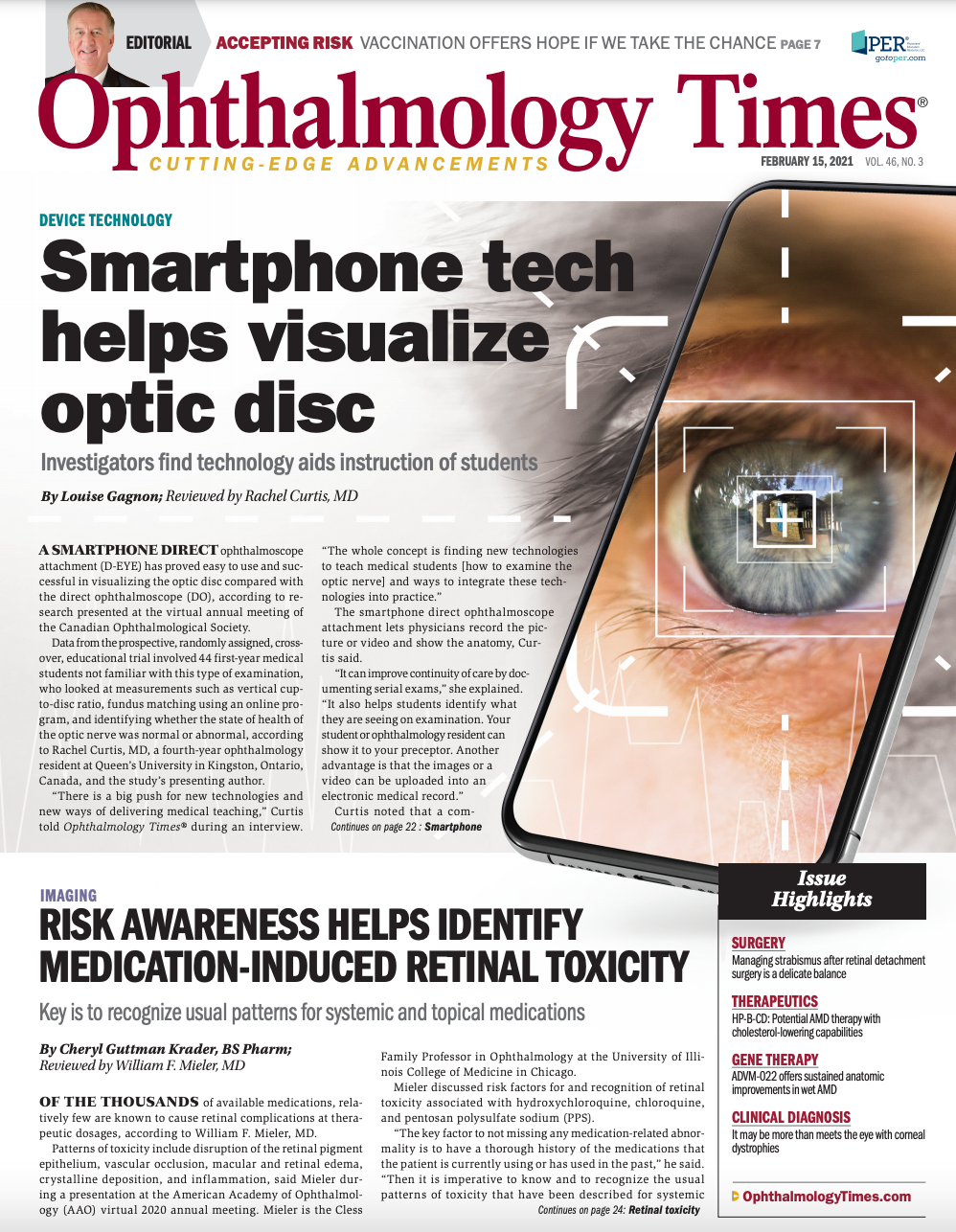Publication
Article
Digital Edition
More than meets the eye with corneal dystrophies
Author(s):
Physician provides contemporary perspective and pearls to guide ophthalmologists.
(FIGURE 1) This image shows a macular dystrophy. (Photo courtesy of Robert S. Feder, MD)


This article was reviewed by Robert S. Feder, MD
The adage of out with the old, in with the new may apply to dictums about dystrophies. Robert S. Feder, MD, offers contemporary perspectives on corneal dystrophies and pearls to guide ophthalmologists.
Feder is a professor of ophthalmology and the chairman of Cornea and External Disease Service at Feinberg School of Medicine at Northwestern University in Chicago, Illinois.
Related: Working out the mystery of ectasia risk with artificial intelligence
Changing the mindset
Physicians have been taught to think of corneal dystrophies as being inherited, bilateral, affecting only 1 layer, and sparing the perilimbal cornea. In addition, they may consider them as progressive and unassociated with systemic disease.
Feder urged physicians to rethink their beliefs about corneal dystrophies in light of the number of exceptions to these rules. He pointed out that they should also consider information garnered from genetic analysis.
This will lead to a new understanding of the relationships between dystrophies and genotypic and phenotypic heterogeneity.
In addition, Feder noted, some of the dystrophies may actually be degenerations, such as epithelial basement membrane dystrophy (EBMD), which is not inherited in most cases.
Related: Returning to baseline post-corneal collagen crosslinking for keratoconus
New technologies, including confocal microscopy, anterior-segment optical coherence tomography (AS-OCT), and corneal tomography, are helpful in differentiating various dystrophies.
Feder offered some examples from the International Classification of Corneal Dystrophies (IC3D) that suggest the merits of a change in our thinking about corneal dystrophies.
“Is keratoconus a dystrophy given that it is inherited in some families? Should cornea plana be considered a dystrophy due to its [being] genetically similar to posterior amorphous stromal dystrophy? Is a ‘new’ dystrophy really new considering its genetic similarity to an existing dystrophy?” he asked.
He also called attention to the misnomer of Schnyder crystalline corneal dystrophy, also known as Schnyder corneal dystrophy, in which crystals are present in only half of cases.
In addition, the presentation of some corneal dystrophies in the pediatric population of patients can differ dramatically from that in seen adults.
Related: Harnessing 1-2 punch of KAMPs for corneal infection, inflammation
New gold standard
The (IC3D)1 is an evidence-based reclassification of corneal diseases created through a collaborative effort of world experts in the field.
“The traditional classification of epithelial, Bowman layer, stromal, and endothelial dystrophies has been adjusted to reflect a contemporary understanding of the dystrophies,” Feder said.
Changes to the second edition of the IC3D combined the epithelial and subepithelial dystrophies, such as the Meesmann Stocker-Holt variant, EBMD, gelatinous drop-like corneal dystrophy, and subepithelial mucinous corneal dystrophy, which now fall under the same umbrella.
The epithelial-stromal transforming growth factor beta-induced (TGFBI) dystrophies now include Reis-Bücklers and Thiel-Behnke; lattice type I, III, and IV; and granular types 1 and 2 dystrophies because they share a similar genetic abnormality.
Related: Are posterior corneal curvature changes culprit in hyperopic shifts?
Painful corneal erosions are common in the diseases of this group because the abnormal keratoepithelin protein interferes with normal adherence at the epithelial basement membrane complex.
Lattice II was removed from the classification as it is familial amyloidosis rather than a corneal dystrophy.
The stromal dystrophy classification more accurately includes macular, congenital hereditary stromal, Schnyder corneal, fleck, posterior amorphous stromal, and pre-Descemet dystrophies.
The endothelial dystrophy classification still includes Fuchs and posterior polymorphous corneal dystrophies; however, the dominant form of congenital hereditary endothelial dystrophies was eliminated from the classification.
Related: Teaching AI algorithms to identify corneal pathology: The future is now
Genetic analysis can help identify a specific dystrophy and aid in patient counseling (increasingly available, although insurance may not pay). Further, new technologies can help clinicians better characterize dystrophies.
(FIGURE 2) In this image, a granular dystrophy is indicated. (Photos courtesy of Robert S. Feder, MD)

A closer look at dystrophies
EBMD is present in 50% of patients with recurrent erosions, but only 10% of patients have symptomatic erosions. Feder advised examining the fellow eye to identify the characteristic fingerprints, maps, and dots of EBMD.
Blurred vision resulting from irregular astigmatism associated with this dystrophy often goes unrecognized; keratometry or corneal topography can identify the irregular astigmatism.
Contact lens overrefraction provides dramatic visual improvement in these patients and may lead surgeons to consider epithelial debridement.
Related: SARS-CoV-2 genomic RNA in corneal transplantation: Are corneal transplantations safe?
Reis-Bücklers and Thiel-Behnke corneal dystrophies are very similar, as they both have the TGFBI genetic abnormality. Modern technology has made the conditions easier to differentiate. Thiel-Behnke, Feder explained, has a honeycomb appearance and Reis-Bücklers, a coarser, fishnet appearance.
AS-OCT shows a sawtooth appearance at Bowman layer in Thiel-Behnke but not in Reis-Bücklers.
Confocal microscopy shows characteristic hyperreflectivity in Reis-Bücklers that is greater than that in Thiel-Behnke, whereas Thiel-Behnke has shadows that are not seen in Reis-Bücklers.
Finally, transmission electron microscopy can be used to demonstrate curly filaments in Thiel-Behnke and rod-shaped bodies in Reis-Bücklers.
Granular corneal dystrophy exhibits 2 forms. The classic type has central opacities in the superficial and mid stroma with intervening clear cornea and peripheral sparing, whereas the Avellino variant is superficial and exhibits both granular and lattice findings.
Related: Doing justice to corneal irregularities
Patients with the TGFBI abnormality should avoid laser refractive surgery because opacities become more prominent. If there is doubt, genetic testing can help.
The classic crystalline lattice lines seen in patients with lattice dystrophy are not seen in children with the disease.
Children typically show stromal haze, dots, and short fine lines. These findings are also seen in keratoplasty patients with recurrent lattice dystrophy.
Fuchs dystrophy has many faces. Early-onset disease can occur in the first decade of life, mostly in females. Transmission microscopy shows a thickened anterior banded layer in Descemet membrane and degenerated endothelial cells.
Late-onset disease (defined as occurring in the fourth decade or later) has numerous genotypes.
Although specular microscopy may be helpful in early disease, Feder commented that it is not useful when the guttata are confluent.
In these cases, pachymetry performed in the morning can identify patients with early endothelial decompensation. These patients may complain of blurred vision in the morning that takes an hour or more to clear.
Related: Changing patient conversations around cataract surgery
In the presence of edema, endothelial keratoplasty is therapeutic and can be combined with cataract surgery. Descemet stripping only is a novel approach for the patient with little lens change and only central corneal involvement. Administrating topical rho-kinase inhibitor may help speed postoperative healing.
Cataract surgery alone can be considered in eyes with guttata but without edema because of the good visual acuity that can be achieved.
If the visualization of the cataract is inadequate due to corneal edema or scarring, open-sky cataract surgery combined with penetrating keratoplasty is still an option.
Feder emphasized that IC3D is the new gold standard for classifying the dystrophies.
Genetic analysis, which is increasingly available, can identify a specific dystrophy and help with patient counseling; however, insurance coverage is not guaranteed.
New technologies can better characterize the dystrophies, which is particularly helpful as presentations in children differ from those in adults.
Related: Hardware, software offer surgeons a window to cornea diagnosis
Phenotypic and genotypic heterogeneity is important to recognize, some dystrophies may actually be degenerations.
“It’s time to rethink the old dictums about dystrophies in terms of classification, diagnosis, and management,” Feder concluded.
--
Robert S. Feder, MD
e:r-feder@northwestern.edu
Feder has no financial interest in this subject matter.
--
Reference
1. Weiss JS, Moller HU, Aldave AJ, et al. IC3D classification of corneal dystrophies—edition 2. Cornea 2015;34:117-159; doi: 10.1097/ICO.0000000000000307

Newsletter
Don’t miss out—get Ophthalmology Times updates on the latest clinical advancements and expert interviews, straight to your inbox.





.png&w=3840&q=75)





























